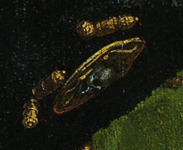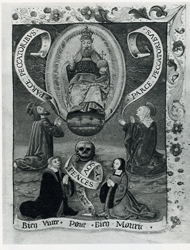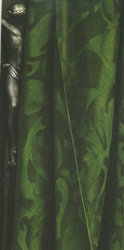

In contemplating the skull, we become profoundly aware of our finiteness and inability of attaining a true vision of God. In order to gain a truer vision of God, one cannot depend on sense and discursive reasoning through the use of the Quadrivium, but must aspire to intellectual vision, visio intellectualis, which is appropriate to angels. Discursive reason depends on dichotomies, by drawing distinctions, by discerning oppositions, while, as Nicholas of Cusa notes:
[T]his unintelligible [Reality] is encountered by the loftiest intellect --freed from all images-- when all things have been transcended." In God, all opposites coincide: "He is beyond everything simple and everything composite, beyond everything singular and everything plural, beyond every limit and all unlimitedness; He is completely everywhere and not at all anywhere; He is of every form and of no form, alike; He is completely ineffable; in all things He is all things, in nothing He is nothing, and in Him all things and nothing are Himself; He is wholly and indivisibly present in any given thing (no matter how small) and, at the same time is present in no thing at all.
Our distinctions of time and place are reconciled in God. The visio intellectualis "...occurs in darkness, where the hidden God is concealed from the eyes of all the wise.' "He is encountered --unlike any other existing thing-- ignorantly, or unintelligibly in a shadow or in darkness or unknowingly."*
Analysis of The Ambassadors in relationship to these ideas of the visio intellectualis and coincidence of opposites presents intriguing analogies. What we see when we examine the painting from the normal point of view is the world as understood by discursive reason. The painting's balanced opposites of active/contemplative and celestial/terrestrial are the products of man's rational ordering of experience. These oppositions, however, are only apparent to man; in God all these oppositions are reconciled. To be able to see the skull, one must abandon one's normal experience of the painting, and approach it from a point of view detached from and ignorant of the world of sense and reason presented by the painting from a frontal point of view. The skull is thus encountered --unlike any other object in the painting-- "ignorantly, or unintelligbly, in a shadow or in darkness, or unknowingly." In contemplating the skull, we, gaining self-knowledge, are made aware of our finiteness. This self-knowledge of one's mortality is alluded to by the brooch with a representation of a skull which Dinteville wears on his cap:

We then desire to come "face to face" with God, and look to Him for our salvation.* A visual parallel to this is found in an early sixteenth century miniature added to a French Book of Hours in the Walters Art Gallery.*

At the bottom of the page are represented a husband and wife kneeling before and contemplating a skull; above, on the same axis as the skull, appears God the Father flanked by the kneeling Christ and Virgin. The patrons, thus, seek to look through the skull to contemplate God. Comparably in the painting, we must look through the anamorphic skull to see the symbol of God, the center of the macrocosm diagram-- a place "concealed from the eyes of all the wise."
"Visio intellectualis" is unattainable through human effort. It is a gift given through faith in Jesus. This is a central idea in Nicholas of Cusa's On Learned Ignorance::
For although hidden from the wise, the very great and very deep mysteries of God are revealed, through faith in Jesus, to the small and humble inhabitants of the world (Matt. 11:25). For Jesus is the one in whom all the treasures of wisdom and knowledge are hidden (Col.2:3), and without Him no one can do anything (John 15:5). For He is the Word and the Power through which God....created even the aeons. Since God is not knowable in this world (where by reason and by opinion or by doctrine we are led, with symbols, through the more known to the unknown), He is apprehended only where persuasive considerations cease and faith appears. Through faith we are caught up, in simplicity, so that being in a body incorporeally (because in spirit) and in the world not mundanely but celestially we may incomprehensibly contemplate Christ above all reason and intelligence, in the third heaven of most simple intellectuality.*
Anticipating the Reformation doctrine of Justification, Nicholas of Cusa writes:
...our justification is not from ourselves but from Christ. Since He is complete fulness, in Him we obtain all things, if we possess Him. Since in this life we attain unto Him by formed faith, we can be justified only by faith.... This is that ineffable mystery of the Cross of our redemption. *
These ideas are central to the thought of Lefèvre d'Etaples and his circle of French Humanist Reformers.* Lefèvre was especially critical of those who attempted to use reason to understand divine matters. With clearly the theological faculty of the Sorbonne in mind, he considered them as fools, and compared their efforts to attain divine truth as like those of a bear or deer seeking to comprehend human thought. Sense and reason cannot possibly comprehend the words of the spirit.* Lefèvre understood there to be an essential difference between human reason and divine sapientia, which was a gift of God.* For Lefèvre all sapientia is a gift through Christ's redemption of humankind:
Jesus Christ and his word is our life, our salvation, our redemption, our glory, our faith, our hope, it is our all: more than all. Because it is an all which is infinite and incomprehensible.*
This point of view is reflected in Lefèvre's approach to Biblical exegesis. In the preface to his edition of the Psalms, Lefèvre condemns as improper the traditional literal sense, the sensus historicus, which interprets the Psalms as "autobiographical" of the life of David. The historical sense, based on sense and reason, "interpret[s] divine things according to the flesh and human categories," and it "kills and opposes the spirit."* For Lefèvre, "Christus Dominus est totius Scripturae Spiritus." (Christ the Lord is the whole spirit of Scripture)*. The Old Testament, unless it is animated by the spirit of Christ, is vain and useless.*
Returning to The Ambassadors, the half-hidden crucifix, the cylindrical sundial probably set for Good Friday, and the German Hymnbook all allude to the gift of redemption offered through Christ's sacrifice and resurrection. In his writings, de Selve refers to Christ as the necessary means proportionate to both God and man to unite man to God. In His divine aspect, Christ is "invisible, impassible, immortel, et egal a Dieu son pere," while in His humanity, Christ is "visible, passible, [et] mortel."* Comparably, we can only see half the crucifix with the other half hidden by the curtain.

The crucifix is thus a link between what we see in the painting and the invisible and unknowable reality that lies behind the curtain.
